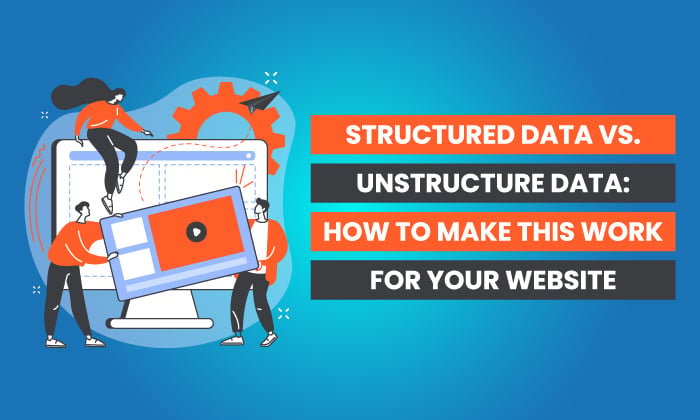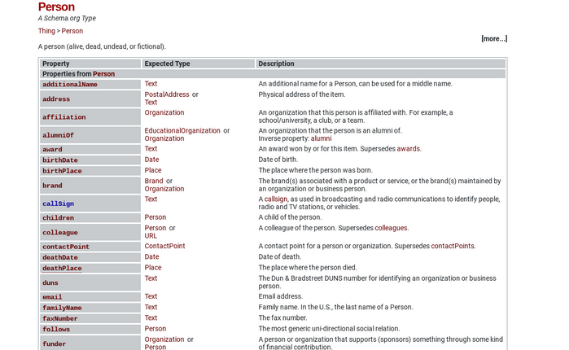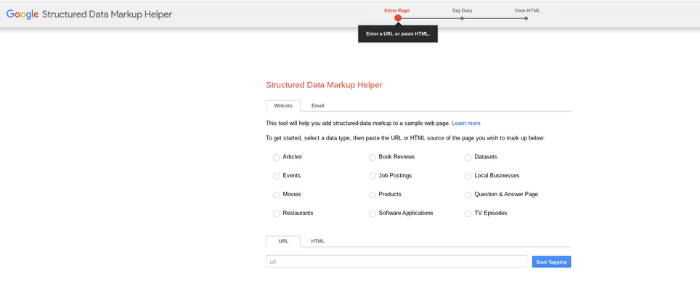
When you’re starting a website, the first thing on your mind probably isn’t structured vs. unstructured data and how it affects your website.
However, the way your information is presented is important. Understanding the distinction and being able to use structured data on your pages can make a big difference to your success.
Here’s what you need to know about structured data vs. unstructured data.
Key Differences Between Structured and Unstructured Data
Structured vs. unstructured data isn’t just a phenomenon in SEO.
It’s a distinction that affects every type of data. For example, on your phone, your contacts are a form of structured data (the names and numbers are categorized into specific fields), but the photos (assuming they have no time or location tags) are considered unstructured data.
- Defined vs. undefined: Structured data fits into predefined models and formats, allowing other applications to understand it better. Unstructured data does not have a predefined model. In SEO, the model we use to interpret structured data is Schema.org, which enables all the search engines to better understand the data of a web page.
- Qualitative vs. quantitative: Unstructured data tends to be qualitative—social media interactions, interviews, images, etc. Structured data is more quantitative, using numbers and predefined fields.
- Differences in storage: Unstructured data can be very complex and require a lot of storage space (think about the images on your site). This unstructured data is normally housed in data lakes, whereas structured data, which is much easier to store, is housed in data warehouses.
- Ease of analysis: Because structured data fits into predefined models and formats, it’s much easier to analyze. In SEO, structured data signals to search engines what a specific piece of information is about so it can be easily understood and served to the public.
What Is Structured Data?
Structured data is data that fits a predefined model or format.
Think about when you pay for something online. You have to fill out a form with your name, contact number, address, and credit card details. You enter each piece of information into clearly defined fields, and each piece of information is saved as structured data.
This makes it easy to search, analyze, and ultimately pull information. If you want to find out how many customers have a 630 area code, you can quickly do that.
If this information was stored in an unstructured way, such as a photo of a person’s business card, then it would be much more challenging to analyze and group the data.
The same principles apply to SEO because Google and other search engines are trying to analyze and group the data on your website.
We already know the importance of structure for SEO when it comes to things like navigation, headings, meta descriptions, and alt texts, but structured data in the form of Schema.org takes this a step further.
If you’re not sure whether you’re using structured data properly, some handy tools like Google’s Structured Data Testing, SNIP WordPress plugin, or Yoast can help.
Pros and Cons of Structured Data
If you look at a search engine results page today, it looks very different from what it did 10 years ago. Back then, SERPs were mostly links and texts, but today, they’re much more interactive. They’re able to pull information from websites to offer you features like rich snippets, frequently asked questions, knowledge graphs, local results, and much more.
Getting your website to feature in these rich results can bring a lot of exposure to your website.

To show this information, Google has to be able to understand your data, and when it comes to structured vs. unstructured data, structured data is the winner. It’s a way of communicating with the search engines that means bots don’t have to assign meaning to every single word.
The search engine can then use this information on the results pages, giving you extra exposure and attracting visitors to your website.
There aren’t really any cons to structured data. The one thing that probably puts people off is the fact that we’re talking about code. However, as I always point out, you don’t have to know how to code to create a successful website today. Many apps and plugins can take care of structured data for you, without you having to worry about coding or HTML.
When to Use Structured Data
There are lots of scenarios where it can be beneficial to use structured data on your page.
For example, you can use schema markup to highlight information about a corporation or person, provide local business information, include important product information, and add recipe instructions. Google can then use this information in its results, allowing you to engage people with data that answers their questions.

Some of the most common uses of structured data include:
- recipe schema markup
- event schema markup
- video schema markup
- article schema markup
- breadcrumbs schema markup
- product and offer schema markup
- local business schema markup
- person schema markup
- organization schema markup
What Is Unstructured Data?
Unstructured data is undefined data that has no set format.
This makes up the majority of data in the world, and the challenge is, what do you do with it? Modern businesses store so much data, but if unstructured data is hard to analyze, then what use is it?
We are getting better at analyzing unstructured data like audio, images, and text that’s not been organized in a specific way, but it’s still challenging. To get insights from this data, we need advanced technology like machine learning and natural language processing.
Think about how driverless cars learn to navigate the roads. They go through thousands of hours of driving footage using machine learning to pick out hazards. It’s complicated stuff!
Google and other search engines have been working on analyzing unstructured data for a long time, sending bots to crawl your website and paint a picture of what it’s about. They’re getting better at this all the time, but unstructured data is still challenging.
Pros and Cons of Unstructured Data
There are lots of times when we use unstructured data because there’s no real need for it to be analyzed. When you send an email, take a picture, or create a voice note, the first thing on your mind isn’t structure.
When it comes to SEO though, you always have to have one eye on structure, because without it, Google is going to have a hard time understanding what your page is about.
How often do you come across a page that’s completely without structure, such as a page that’s just a big block of text with some images thrown in? You probably don’t see pages like that very often because they’re hard to index (as well as provide a poor user experience).
This is why even if we’re not using structured data in the form of Schema.org, we are using semi-structure in the form of meta descriptions, H1s, H2s (here’s how headers impact your SEO), alt text, and more.
Unstructured data is convenient because we don’t have time to structure every piece of data, and in many cases, there’s no need to do so. However, in SEO, we do need some level of structure, at least on a page level.
When to Use Unstructured Data
Not everything you put on your website is going to use structured data. You can’t mark up every paragraph and assign meaning to it; sometimes a paragraph is just a paragraph, and that’s fine.
Search engines do have the ability to understand what your text is about. It might not learn as much as it does through structured data, but it still helps it to assign value and understand what your pages are about.
The balance of structured data vs. unstructured data on your website is going to lean towards unstructured, just because everything you write doesn’t need to fit a defined model. Use the structured data to highlight the most important parts of your page, and don’t worry about marking up every little detail.
How to Prepare Your Website for Future Structured, Unstructured, and Semi-structured Data Best Practices
If we look at the evolution of the SERPs, it’s evident that structured data plays a much bigger role than it used to.
Structured data might not be a ranking signal, but it does allow Google to use your data to fill its rich features. These rich features appear on virtually every results page, so they’re something that’s going to have a big impact on your website’s visibility (the difference between featuring on a local business pack, or not, for example, can be huge.)
The good thing is that the nature of structured data, with its clear structures and formats, means best practices aren’t likely to change dramatically with time. All of the search engines work with Schema.org, and it’s a very accessible, collaborative “organization.”
If and when changes are made, you can easily find out on the Schema.org website and adjust your approach accordingly, and of course, the apps you use to help you with structured data will keep updating.
Likewise, semi-structured and unstructured data are always going to play a part. You can’t structure every single word on your website, so it’s about following established SEO best practices and focusing on what gives your visitors the best possible user experience.
How to Implement Structured Data
Structured data can help you organize information on your website and communicate more efficiently with the search engines, but how do you implement it?

- Open Google’s Structured Data Markup Helper. This is a free tool that will help you create the code for your structured data.
- Select the data type you want to use and add the URL for the page. This will automatically collect any existing formatting.
- Highlight page elements and assign tags. From this page, you can highlight elements like images, sentences, and paragraphs, and assign tags to them.
- Create the HTML. The tool will create a snippet of code for you to add to the header of your page.
- Copy the HTML and add it to your page. You can add the HTML into your source code or CMS.
- Test your structured data using Schema.Org’s Schema Markup Validator. You can enter your URL or the HTML code to test whether the structured data is showing properly.
This process makes it simple to add structure to your data and helps Google understand crucial details about your pages.
Structured Data Frequently Asked Questions
What are some structured data testing tools?
The most simple tool is Schema.org’s Schema Markup Validator, which gives you a quick, easy analysis of how your page uses structured data. Other options include Schema App, Yoast, RankRanger, or a Chrome plugin.
What is a structured data example?
A good example of structured data is the recipe schema markup. This allows you to add ingredients and recipe steps among other information that can then be displayed in search results.
What is the use of structured data?
Structured data makes your data easier to analyze. In SEO, this means search engines can better understand what your page is about and use important information in the SERPs.
Is structured data good for your SEO?
Structured data helps Google understand what your page is about, which benefits SEO. It might not be a ranking factor, but it does help Google show your data in its rich results.
Conclusion: Structured Data
How you structure information is important in SEO. You want to make it as easy as possible for search engines to interpret what you’re talking about, and structured data can help you do this.
The format that we use to structure data in SEO is called schema, and many tools can help you use this “language” effectively. If you do, then your website will be able to show in rich results that can catch the eye of searchers and attract visitors to your website.
Structured data might be a small detail, but it can make a difference to the success of your website.
Are you using structured data on your site?
from Blog – Neil Patel https://ift.tt/2mYCmnI

No comments:
Post a Comment